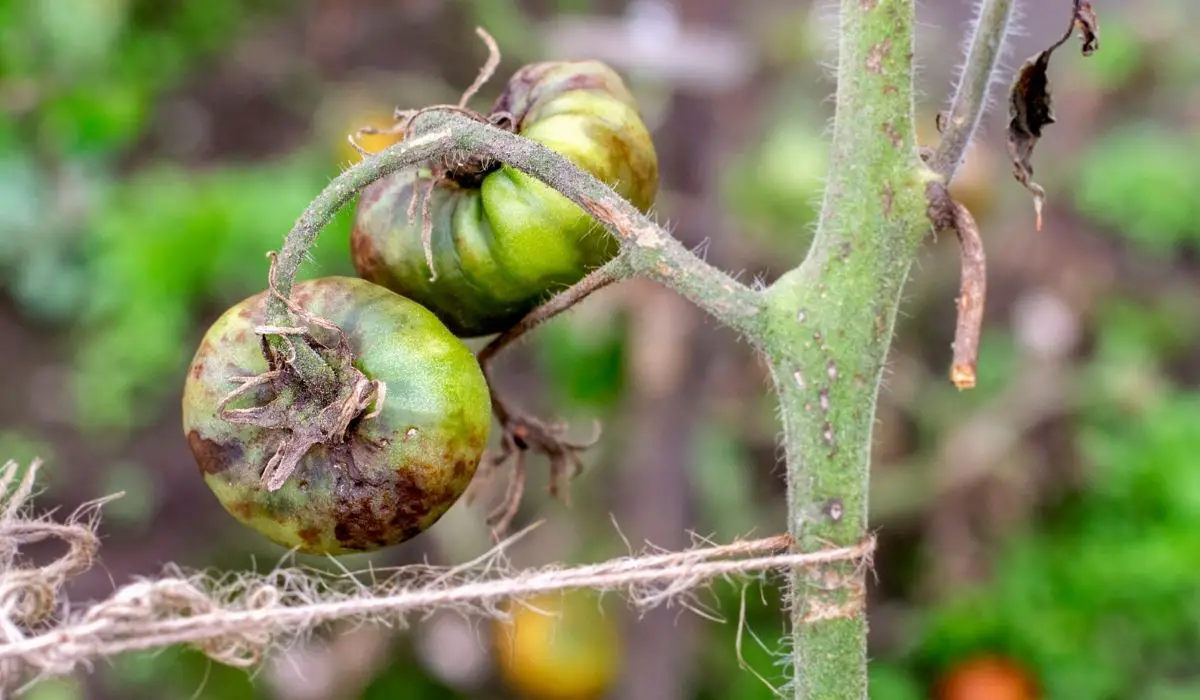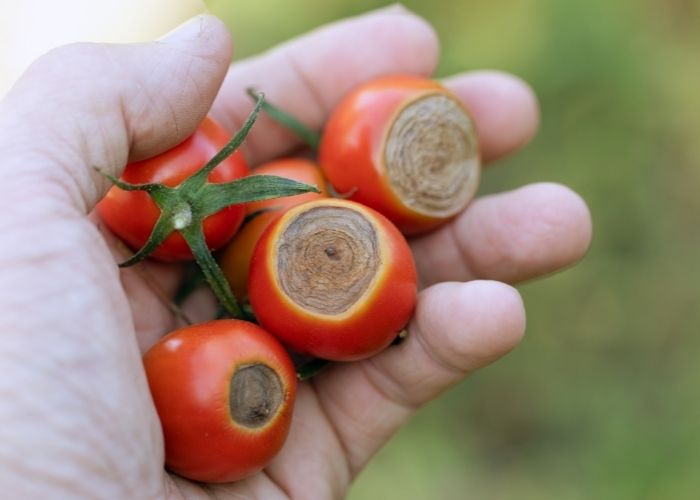Last Updated on March 20, 2023 by Cristina
The bottom of tomatoes rotting is something most tomato gardeners face, especially during the last stages of growth and ripening of the fruit.
You have planted your tomato seeds, watched them grow, and now you are finally starting to get some beautiful fruits.
Then out of nowhere, you begin to notice some disgusting black scab on the bottom of your beautiful tomato fruit.
This article will discuss what this horrible scab ruining your tomatoes is called and how to treat it.
What Is The Bottom Of Tomatoes Rotting Called?
The ugliest car at the bottom of your tomato is called blossom end rot. This water soft spot is the classic symptom of bottom rot on tomatoes. It is not a disease but a physiological disorder caused by a calcium imbalance within the plant.
Bottom end rot can occur in squash, pepper, melon fruits, cucumber, and tomatoes. Tomato end rot is a common tomato disease, and the growing season starts wet and then becomes dry when the fruit is setting. The damage first appears when fruits are approximately half their full size. The soft water areas enlarge, turning to dark brown and leathery, eventually beginning to rot.
What Causes The Bottom Of Tomatoes Rotting
Tomato rot is caused by the inability to get enough calcium to the developing fruit. Bacteria or fungus do not cause this calcium deficiency; instead, several factors cause blossom end rot. They include
- Too little or too much moisture. When you have prolonged dry conditions or too wet, they could affect your tomatoes, causing rot.
- Too much nitrogen. If you provide too much fresh manual for your tomatoes, the result is lots of green foliage and black-bottomed fruit. The nitrogen in the soil could make calcium less available to the tomatoes.
- The soil could be too cold during planting. This is an issue for Northern gardeners; if the ground is too hard, it interferes with the plant’s nutrient uptake.
- The soil pH could be too high or too low. Extremes of the PH value in your soil can make it difficult for your tomatoes to thrive.
- Root damage due to cultivation. Aggressive digging around your tomato plants could damage the roots and interfere with nutrient uptake, especially for weed control.
- Growing susceptible tomato varieties. Some tomato varieties are more prone to blossom and drought than others.
How To Prevent Blossom End Rot
When you notice black or dark brown support at the end of your tomatoes, know they are gone, and you cannot heal the damaged tomato fruit.
It would help if you focused more on prevention and control measures to salvage the rest of your tomato plants before they are attacked. Here are steps to follow in doing so
Maintain Consistent Levels Of Moisture In Your Plants
Mulching helps maintain even soil moisture levels. If there is no rainfall, ensure you give your plants a good soaking at least 1 to 2 times a week. To test the soil moisture, stick your fingers in the dirt around the tomato plant and check if it’s soaked several inches down.
You can use water cones or soaker hoses to provide a slow, steady supply of water. If you are receiving heavy rains, drain the excess moisture away from your tomatoes if possible to avoid waterlogging.
Container-grown tomatoes are more prone to blossom end rot due to difficulty keeping the soil moist enough.
Invest In A Balanced Fertilizer
Compost or aged manure is a great way to provide the proper nutrients for tomatoes because they’re heavy feeders. Do not use too much fresh manure as it contains too much nitrogen. There are also other good organic fertilizers that you can invest in to give your plants a jump-start.
Ensure Your Soil Is Warm Enough When Planting
To germinate, tomato seeds require at least 60 degrees Fahrenheit. Seedlings are ready to go into the soil above 55 degrees Fahrenheit, but growth will be slow.
The general rule to follow when planting your seedlings is to wait until the nighttime temperatures are above 55 degrees Fahrenheit. You can use a salt thermometer to test your soil temperatures.
Cover your planting area with black or red plastic, or patiently wait until the weather warms up to raise your soil temperature. During the summer heat, you can use organic mulch to keep the roots from overheating.
Avoid Working Too Close To The Roots Of The Tomato Plant
When pulling weeds, don’t attack the ground close to the tomato plant with your hoe. Mulching your tomato garden limits the need for cultivation during the growing period.
Check Your Soil pH Before Planting
Soil pH should be between 6.2 to 6.8 to provide the right growing environment for tomatoes. You can carry out a soil test before planting your tomatoes to get the whole composition of your soil.
Adjust your soil with additional calcium by adding lime to your garden to raise the soil pH. Use organic mulches and compost manure to lower your soil pH over time.
Add Calcium To Your Soil
If your soil requires additional calcium, you can add crushed eggshells or add a few calcium and antacid tablets during planting time.
A handful of gypsum or garden lime also works; sprinkle is little lime onto the soil surface and works gently, covering it with mulch and watering well.
Choose the tomato varieties that are less susceptible to blossom end rot
Some of the types that are highly susceptible to blossom end rot include orange banana, better boy, San Marzano.
Some of the varieties are primarily unaffected; they include glow beauty, glacier, Amish paste, black cherry, Opalka, Arkansas traveler, Tigerella, and mortgage lifter.
Final Thoughts
Bottom of tomatoes rotting or blossom end rot does not spread from plant to plant. However, plants growing near each other may all be affected since they share similar growing conditions.
Damaged tomatoes can be trimmed off, and the rest is eaten. However, if the rot is too big, you can only discard the spoilt tomatoes. With the information broken down, it is easy to fight the tomato rot.
Learn more about When To Apply Fertilizer To Vegetable Garden.
Caroline is a gardener who loves to get down to the nitty–gritty of gardening. She proudly proclaims herself as a ‘dirt worshipper‘ and can often be found deep in the garden, covered in soil and singing to her plants. As a self–proclaimed ‘plant whisperer‘, Caroline believes that plants need love and attention just like any other living thing, and she loves to give them both. When she‘s not tending to her garden, you can often find her researching the latest gardening trends, or teaching others how to make their gardens thrive




